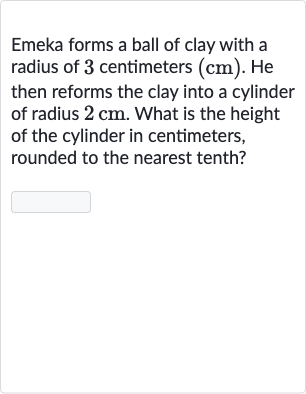Full solution
Q. Emeka forms a ball of clay with a radius of centimeters . He then reforms the clay into a cylinder of radius . What is the height of the cylinder in centimeters, rounded to the nearest tenth?
- Calculate Volume of Sphere: First, calculate the volume of the ball of clay using the formula for the volume of a sphere, which is , where is the radius of the sphere.Given radius of the sphere (ball of clay) cm, the volume .Calculation:
- Calculate Volume of Cylinder: Since the clay is reformed into a cylinder without any loss of material, the volume of the cylinder will be equal to the volume of the sphere.Let's denote the height of the cylinder as . The formula for the volume of a cylinder is , where is the radius of the cylinder.Given radius of the cylinder , and the volume , we have .
- Solve for Cylinder Height: Solve for the height of the cylinder.To find , divide both sides by .
- Simplify Equation for Height: Simplify the equation to find the height .Round the height to the nearest tenth.The height is already an integer value, so rounding to the nearest tenth will not change the value.
More problems from Pythagorean theorem
QuestionGet tutor help
QuestionGet tutor help
QuestionGet tutor help
QuestionGet tutor help
QuestionGet tutor help
QuestionGet tutor help
QuestionGet tutor help
QuestionGet tutor help
QuestionGet tutor help

